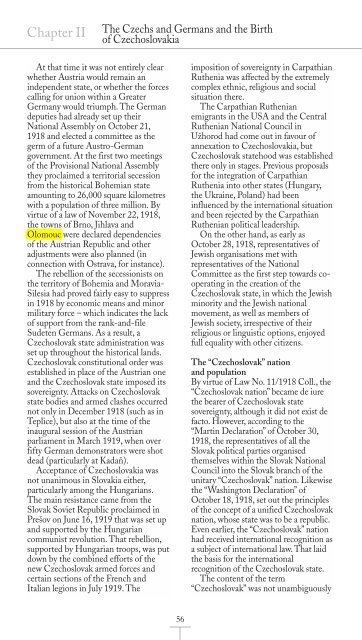the nationality of all inhabitants of the czech provinces and ...
the nationality of all inhabitants of the czech provinces and ...
the nationality of all inhabitants of the czech provinces and ...
Create successful ePaper yourself
Turn your PDF publications into a flip-book with our unique Google optimized e-Paper software.
Chapter II<br />
At that time it was not entirely clear<br />
whe<strong>the</strong>r Austria would remain an<br />
independent state, or whe<strong>the</strong>r <strong>the</strong> forces<br />
c<strong>all</strong>ing for union within a Greater<br />
Germany would triumph. The German<br />
deputies had already set up <strong>the</strong>ir<br />
National Assembly on October 21,<br />
1918 <strong>and</strong> elected a committee as <strong>the</strong><br />
germ <strong>of</strong> a future Austro-German<br />
government. At <strong>the</strong> first two meetings<br />
<strong>of</strong> <strong>the</strong> Provisional National Assembly<br />
<strong>the</strong>y proclaimed a territorial secession<br />
from <strong>the</strong> historical Bohemian state<br />
amounting to 26,000 square kilometres<br />
with a population <strong>of</strong> three million. By<br />
virtue <strong>of</strong> a law <strong>of</strong> November 22, 1918,<br />
<strong>the</strong> towns <strong>of</strong> Brno, Jihlava <strong>and</strong><br />
Olomouc were declared dependencies<br />
<strong>of</strong> <strong>the</strong> Austrian Republic <strong>and</strong> o<strong>the</strong>r<br />
adjustments were also planned (in<br />
connection with Ostrava, for instance).<br />
The rebellion <strong>of</strong> <strong>the</strong> secessionists on<br />
<strong>the</strong> territory <strong>of</strong> Bohemia <strong>and</strong> Moravia-<br />
Silesia had proved fairly easy to suppress<br />
in 1918 by economic means <strong>and</strong> minor<br />
military force – which indicates <strong>the</strong> lack<br />
<strong>of</strong> support from <strong>the</strong> rank-<strong>and</strong>-file<br />
Sudeten Germans. As a result, a<br />
Czechoslovak state administration was<br />
set up throughout <strong>the</strong> historical l<strong>and</strong>s.<br />
Czechoslovak constitutional order was<br />
established in place <strong>of</strong> <strong>the</strong> Austrian one<br />
<strong>and</strong> <strong>the</strong> Czechoslovak state imposed its<br />
sovereignty. Attacks on Czechoslovak<br />
state bodies <strong>and</strong> armed clashes occurred<br />
not only in December 1918 (such as in<br />
Teplice), but also at <strong>the</strong> time <strong>of</strong> <strong>the</strong><br />
inaugural session <strong>of</strong> <strong>the</strong> Austrian<br />
parliament in March 1919, when over<br />
fifty German demonstrators were shot<br />
dead (particularly at Kadaň).<br />
Acceptance <strong>of</strong> Czechoslovakia was<br />
not unanimous in Slovakia ei<strong>the</strong>r,<br />
particularly among <strong>the</strong> Hungarians.<br />
The main resistance came from <strong>the</strong><br />
Slovak Soviet Republic proclaimed in<br />
Prešov on June 16, 1919 that was set up<br />
<strong>and</strong> supported by <strong>the</strong> Hungarian<br />
communist revolution. That rebellion,<br />
supported by Hungarian troops, was put<br />
down by <strong>the</strong> combined efforts <strong>of</strong> <strong>the</strong><br />
new Czechoslovak armed forces <strong>and</strong><br />
certain sections <strong>of</strong> <strong>the</strong> French <strong>and</strong><br />
Italian legions in July 1919. The<br />
The Czechs <strong>and</strong> Germans <strong>and</strong> <strong>the</strong> Birth<br />
<strong>of</strong> Czechoslovakia<br />
56<br />
imposition <strong>of</strong> sovereignty in Carpathian<br />
Ru<strong>the</strong>nia was affected by <strong>the</strong> extremely<br />
complex ethnic, religious <strong>and</strong> social<br />
situation <strong>the</strong>re.<br />
The Carpathian Ru<strong>the</strong>nian<br />
emigrants in <strong>the</strong> USA <strong>and</strong> <strong>the</strong> Central<br />
Ru<strong>the</strong>nian National Council in<br />
Užhorod had come out in favour <strong>of</strong><br />
annexation to Czechoslovakia, but<br />
Czechoslovak statehood was established<br />
<strong>the</strong>re only in stages. Previous proposals<br />
for <strong>the</strong> integration <strong>of</strong> Carpathian<br />
Ru<strong>the</strong>nia into o<strong>the</strong>r states (Hungary,<br />
<strong>the</strong> Ukraine, Pol<strong>and</strong>) had been<br />
influenced by <strong>the</strong> international situation<br />
<strong>and</strong> been rejected by <strong>the</strong> Carpathian<br />
Ru<strong>the</strong>nian political leadership.<br />
On <strong>the</strong> o<strong>the</strong>r h<strong>and</strong>, as early as<br />
October 28, 1918, representatives <strong>of</strong><br />
Jewish organisations met with<br />
representatives <strong>of</strong> <strong>the</strong> National<br />
Committee as <strong>the</strong> first step towards cooperating<br />
in <strong>the</strong> creation <strong>of</strong> <strong>the</strong><br />
Czechoslovak state, in which <strong>the</strong> Jewish<br />
minority <strong>and</strong> <strong>the</strong> Jewish national<br />
movement, as well as members <strong>of</strong><br />
Jewish society, irrespective <strong>of</strong> <strong>the</strong>ir<br />
religious or linguistic options, enjoyed<br />
full equality with o<strong>the</strong>r citizens.<br />
The “Czechoslovak” nation<br />
<strong>and</strong> population<br />
By virtue <strong>of</strong> Law No. 11/1918 Coll., <strong>the</strong><br />
“Czechoslovak nation” became de iure<br />
<strong>the</strong> bearer <strong>of</strong> Czechoslovak state<br />
sovereignty, although it did not exist de<br />
facto. However, according to <strong>the</strong><br />
“Martin Declaration” <strong>of</strong> October 30,<br />
1918, <strong>the</strong> representatives <strong>of</strong> <strong>all</strong> <strong>the</strong><br />
Slovak political parties organised<br />
<strong>the</strong>mselves within <strong>the</strong> Slovak National<br />
Council into <strong>the</strong> Slovak branch <strong>of</strong> <strong>the</strong><br />
unitary “Czechoslovak” nation. Likewise<br />
<strong>the</strong> “Washington Declaration” <strong>of</strong><br />
October 18, 1918, set out <strong>the</strong> principles<br />
<strong>of</strong> <strong>the</strong> concept <strong>of</strong> a unified Czechoslovak<br />
nation, whose state was to be a republic.<br />
Even earlier, <strong>the</strong> “Czechoslovak” nation<br />
had received international recognition as<br />
a subject <strong>of</strong> international law. That laid<br />
<strong>the</strong> basis for <strong>the</strong> international<br />
recognition <strong>of</strong> <strong>the</strong> Czechoslovak state.<br />
The content <strong>of</strong> <strong>the</strong> term<br />
“Czechoslovak” was not unambiguously


